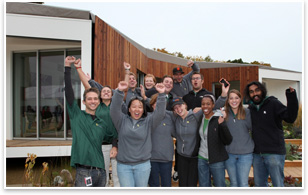California Team Holding the Solar Decathlon Lead
Competition winner announced October 16
Summary: The California Team and their Refract House had the lead at press time in the 2009 Solar Decathlon, with Team Germany and Illinois trailing closely behind. The California Team, which comprises students from Santa Clara University and the California College of the Arts, received accolades October 13 from AIA President-elect George Miller, FAIA, as he awarded them first place in the architecture portion of the competition. The AIA is a Solar Decathlon co-sponsor. The architecture jury conferred 98 out of a possible 100 points for the Refract House design.

Team California celebrates October 12 on their design event victory
Photo Credit: Stefano Paltera/U.S. Department of Energy Solar Decathlon .
"The beauty of California comes through in this design and the use of windows," says Project Manager Allison Kopf, a student at Santa Clara University. The bent design takes maximum advantage of south-facing vistas from the inside, making it seem larger. The patio area is incorporated visually into the house space.
"During the summer, you can leave the doors open and your 800-square-foot house becomes much larger," says Santa Clara University Engineering Team Leader Timothy Sennott. "The courtyard and the rear deck become part of your living experience."
Refract House takes full advantage of the ample California sun with passive systems eliminating the need for a heating system. Radiant panels cool the building, with heat recovered from the chiller preheating water feeding into the solar hot water system. To top it off, the roof is an unbroken plane of photovoltaic panels.
The house, which had earned 505.916 points mid-week—Germany had 489 and Illinois had 488 after 7 of the 10 competition events—features:
- A monitoring system that displays the house's performance and works with an iPhone application to let users control temperature and lighting from anywhere
- A graywater pond that nourishes the landscape
- Windows with low-e glass, heat mirror film, and krypton or argon fill
- A solar thermal absorption chiller that operates the radiant cooling panels
- Solar panels in two series that generate up to 8.1 kW of direct current power, which is converted to alternating current for use in the house
- A bent rectangle design that incorporates the patio into the house
- Built-in furniture that conserves space.
|


